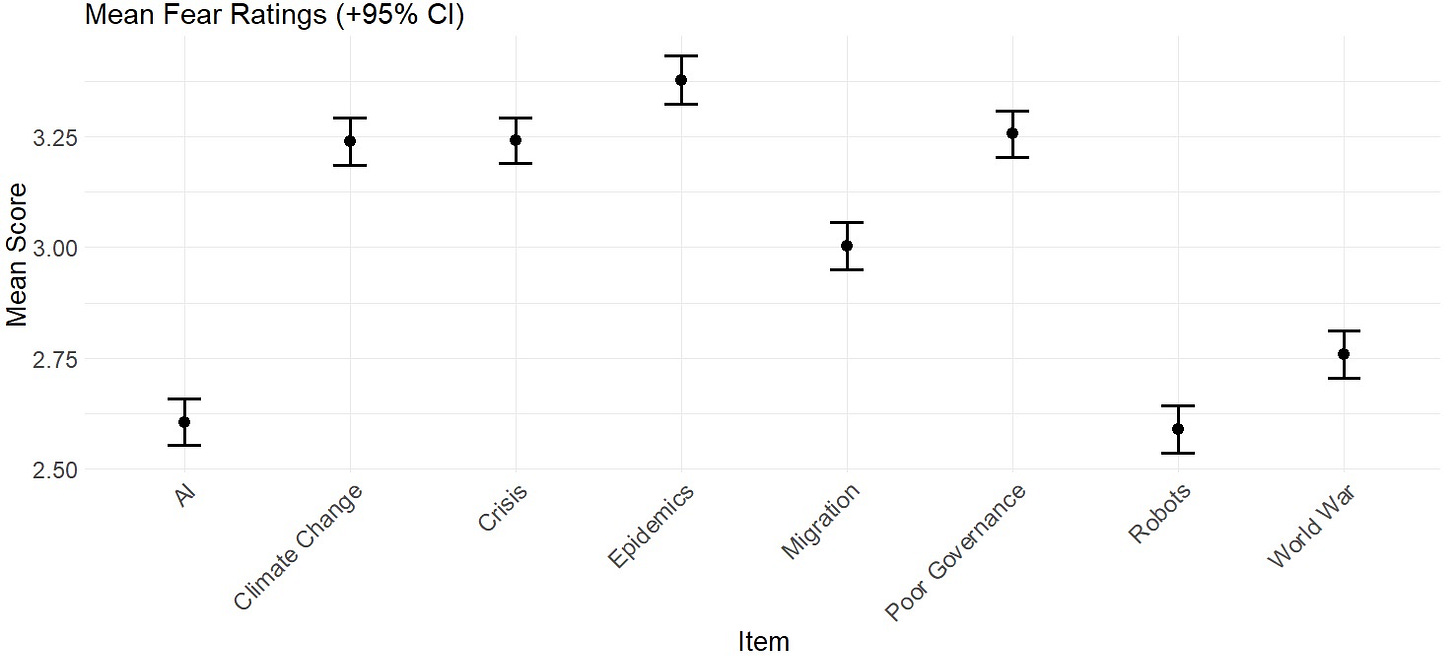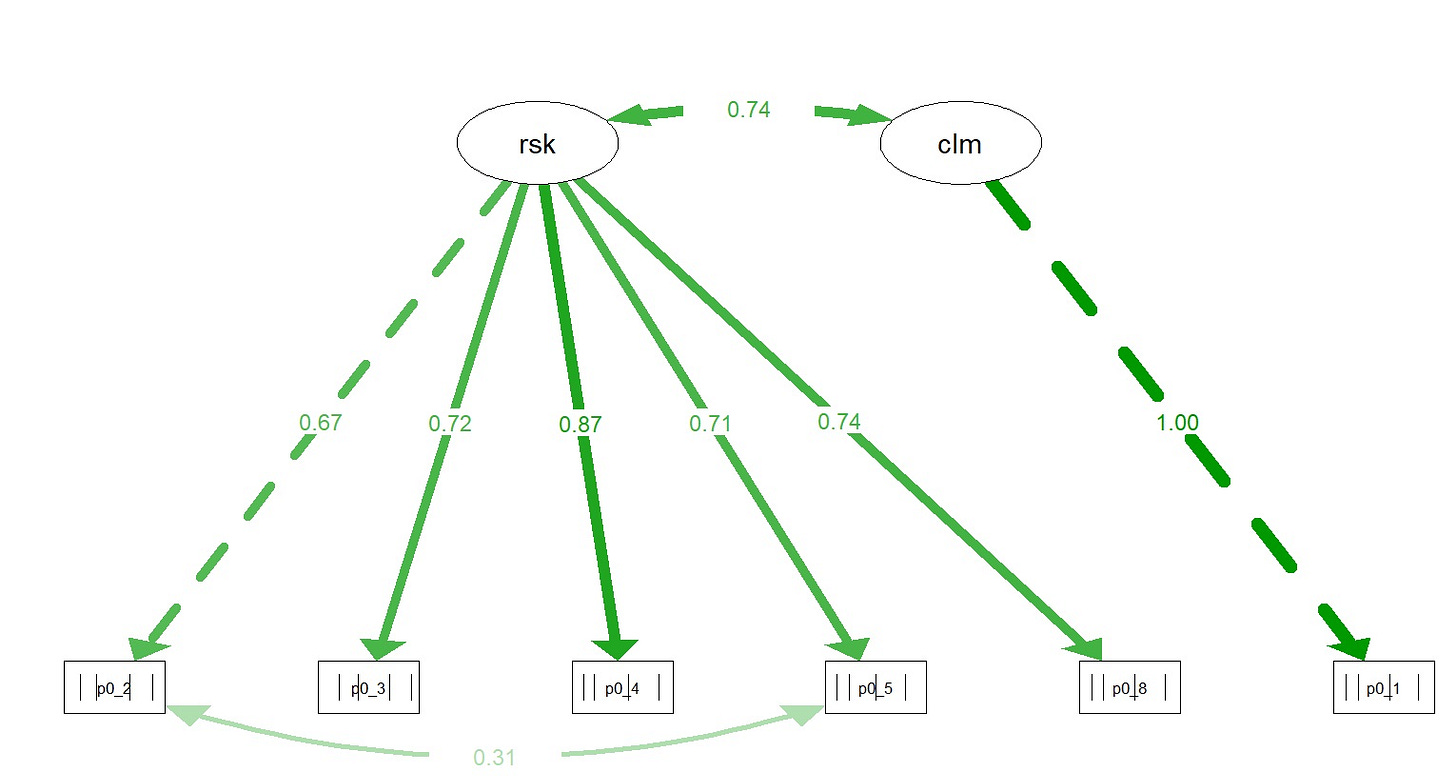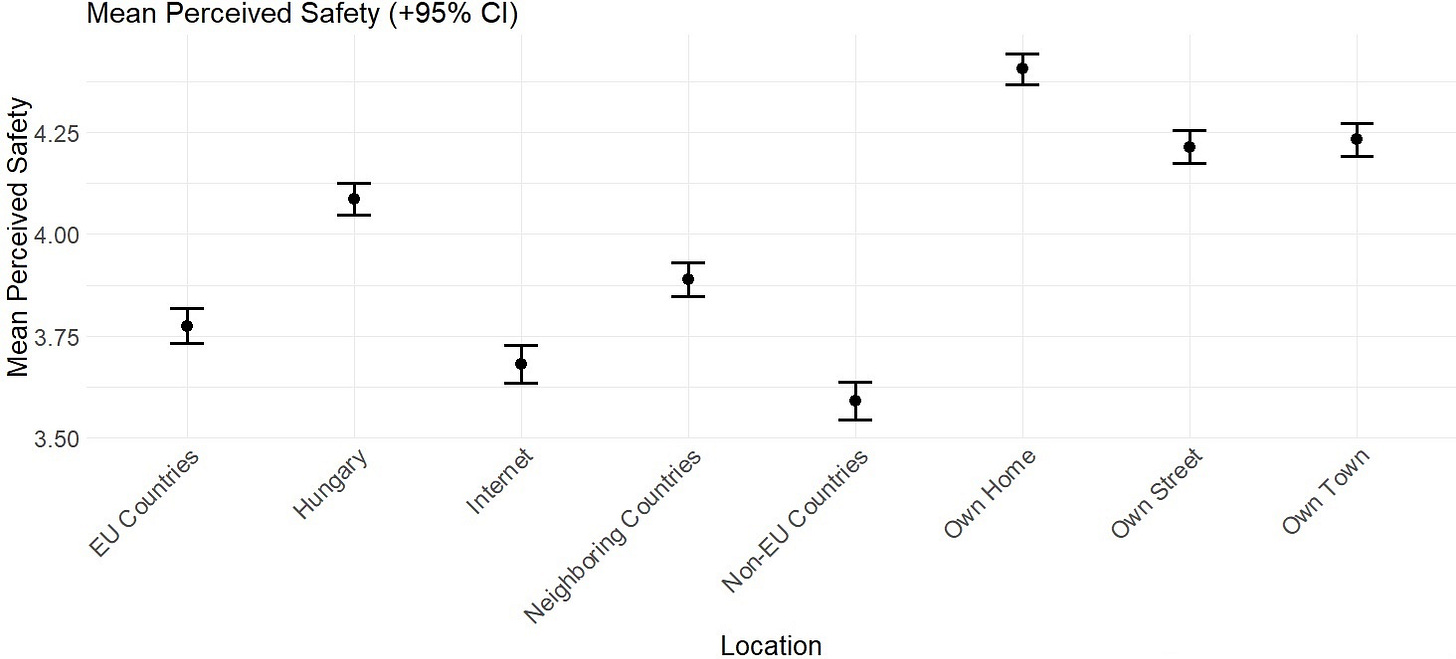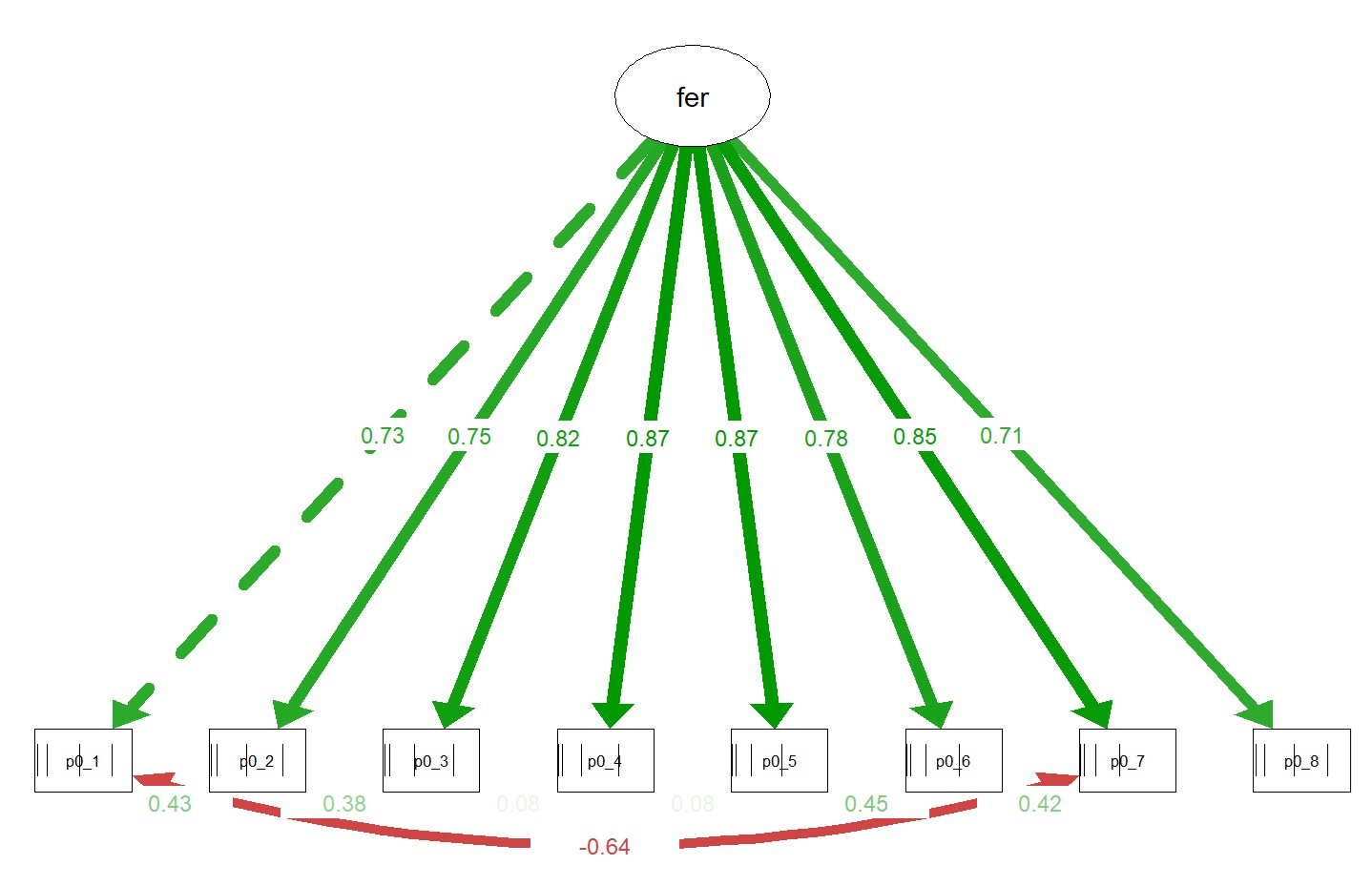Climate anxiety is not a rational fear – a psychometric replication
Worrying about catastrophes is a separate psychological construct
In my previous post, I set out to investigate if climate anxiety is a rational fear or just a reflection of a more general psychological trait of “dooming” – being afraid of civilization-altering disasters. My logic was that if people were rationally afraid of climate change, their fear should be roughly statistically independent of other fears. In an objectively dangerous situation – alone in a dark alley in a bad neighborhood, in a trench under an artillery barrage – even normally calm people are afraid. General anxiety-proneness should be a poor predictor of anxiety in these situations. On the other hand, if the only people afraid of something are those who are normally afraid of things anyway, this suggests that being afraid of that thing is not a rational fear, but a reflection of a more general anxiety. In a unique sample of people reporting their worry of various disasters, I found strong evidence of a “dooming” factor – a general fear of disasters, not very strongly related to depression or general anxiety – and climate anxiety was just a part of this. Some people worry more about disasters - sometimes mutually exclusive ones - than others, and climate anxiety is just part of this tendency.
In this post, I replicate this finding using another large representative sample of Hungarians, (N=8000, although only ~2000 participants were asked the necessary questions).
In this dataset, participants indicated how afraid they are of some disasters on a scale of 1-5 („Absolutely not afraid” to „Very afraid”). The disasters are „climate change”, „migration to Europe”, „an upcoming World War”, „an upcoming economic crisis”, „a pandemic”, „AI”, „robots taking people’s jobs” and „politicians governing the country poorly”. Mean scores:
Nothing too surprising. In the middle of COVID, pandemics seems the scariest. This is followed up by climate change and two very down-to-earth problems (economic crisis and poor governance. A world war seemed less threatening in 2020, and AI/robots the least. Item correlations:
This looks like a decent positive manifold, but a simple single-factor model doesn’t fit it very well. The AI and robots items don’t fit the others, not even as a factor of their own, so I decided to drop them. This way, a single common-factor model has borderline fit (TLI/CFI~0.99, SRMR=0.042, RMSEA=0.095). A residual correlation of 0.09 remains between a fear of migration and a pandemic: adding this to the model this reduces RMSEA to 0.065 and improves the other indices as well. I didn’t want to torture the model further: with some quirks, modelling a fear of these disasters as originating from a single “dooming” factor fits the data reasonably well.
Because only one item is about climate anxiety, it’s hard to tell how much of it is just dooming. Normally one would take several items, fit a latent factor to them, fit another latent factor to the dooming items, and calculate the correlation of the two latent factors: the error-free similarity of “climate anxiety” and “dooming”. I estimated this to be 0.85 in my previous post. Here, the best I can do is a model that looks like this:
Here, “climate anxiety” is measured by just a single item with a fixed loading of 1, and “dooming” (“rsk” for “risk”) by five others. Item 2 and 5 are “migration” and “epidemics”: fear of these is more similar than implied by a single factor so a residual correlation is necessary. This model gives me a latent correlation of 0.74[1], still quite high and biased downward by the fact that that “latent” climate anxiety factor is equal to the item score due to the fixed loading. Fit is pretty good: TLI=0.997, CFI=0.995, RMSEA=0.065, SRMR=0.028.
It’s fair to say that even in this dataset, a fear of climate change is mostly just a reflection of a broader fear of mutually exclusive societal disasters. “Climate anxiety” is very similar to just “worrying about societal problems”. Only a fear of economic crises has a higher correlation with the dooming factor.
The next step is to compare this “dooming” factor to other psychological measures. My dataset has a questionnaire about symptoms of depression and anxiety, which I wrote about before. A single factor model has excellent fit to both the depression (TLI/CFI=1, RMSEA=0.028, SRMR=0.01) and the anxiety (TLI/CFI~1, RMSEA=0.05, SRMR=0.02) items, but depression is unfortunately only available to a subset of the sample with no overlap with dooming data, so we can’t use it. The dataset also has items about fear in a more specific sense which I think is interesting to compare to dooming. The questions were a bit weird, because participants were asked to say how safe they feel (1-5 Likert scale) in environments increasingly close to their immediate surroundings, specifically: 1) non-EU countries, 2) other EU countries, 3) countries neighboring Hungary, 4) in Hungary, 5) in their town, 6) in their neighborhood, 7) at home, 8) on the Internet. I don’t think the modal Hungarian teenager has a strong opinion about his personal safety in non-EU countries, but maybe the scale is a good indicator of a type of anxiety more similar to dooming and less to conventional anxiety scales.
Very simple, the farther away, the less safe. Item correlations are weird:
The reds fading out as we go away from the diagonal shows that there is an autoregressive relationship between the items. With increasing distance between the environments, the similarity of fear decreases: “non-EU” is more similar to “other EU” (both quite distant) than to “own home” (very close). This is what we typically see in longitudinal studies where more temporally close measurements tend to be more similar. It’s interesting to see that the internet behaves like a distant place! Together with the means decreasing away from “Own home” it tells me that participants don’t really have strong opinions about how safe they feel in these different environments, the scale just measures a general feeling of safety. This is bad news for the survey makers, but good news for us, because we want to measure a general feeling of safety.
I tried to solve the autocorrelation problem by allowing a residual correlation between each adjacent pair of items, something like this:
Note that subsequent items are always more similar than predicted by the single factor. The last item is the internet, for that one I didn’t include a residual correlation. Even this way (and by adding one more residual correlation between “non-EU” and “home”, the big red arrow) the model doesn’t fit very well (CFI/TLI=0.99, RMSEA=0.125, SRMR=0.06) so take results about this fear factor with a grain of salt.
When I combine these items with dooming and the life satisfaction scale in a single model, the latent fear, dooming and life satisfaction factors end up correlating like this:
The model has borderline fit (CFI/TLI=0.99, RMSEA=0.07, SRMR=0.06), mostly because of the poor fear model. Dooming is quite poorly correlated with either a feeling of personal safety or life satisfaction. Worrying about climate change is not the same as depression or anxiety, but it is not a separate, well-founded fear either. Worrying about climate change is part of “dooming”, a specific tendency to worry about catastrophic, sometimes mutually exclusive future events.
[1] This is the same as if the climate item was just included as an indicator of the dooming factor: 0.74*1=0.74. I tried fitting the model that way and it returns this exact number. I should be able to freely estimate the climate item loading instead of fixing it to 1 as long as the variance of the latent climate anxiety factor is fixed to 1: however, when I do that, the model is not identified. This is indirect evidence that lavaan has problems telling the “dooming” and “climate anxiety” factors apart, but I admit that I hoped for a properly estimated latent correlation.










Otherwise rational people with whom I have discussed climate change ignore any contrary evidence (no trends in climate disasters, models running hot, the minimal effect that Paris will have on temperatures) and retreat into their safe zone by repeating the standard climate catastrophe talking points. My conclusion is that having irrational fears provides a comfort of some kind.